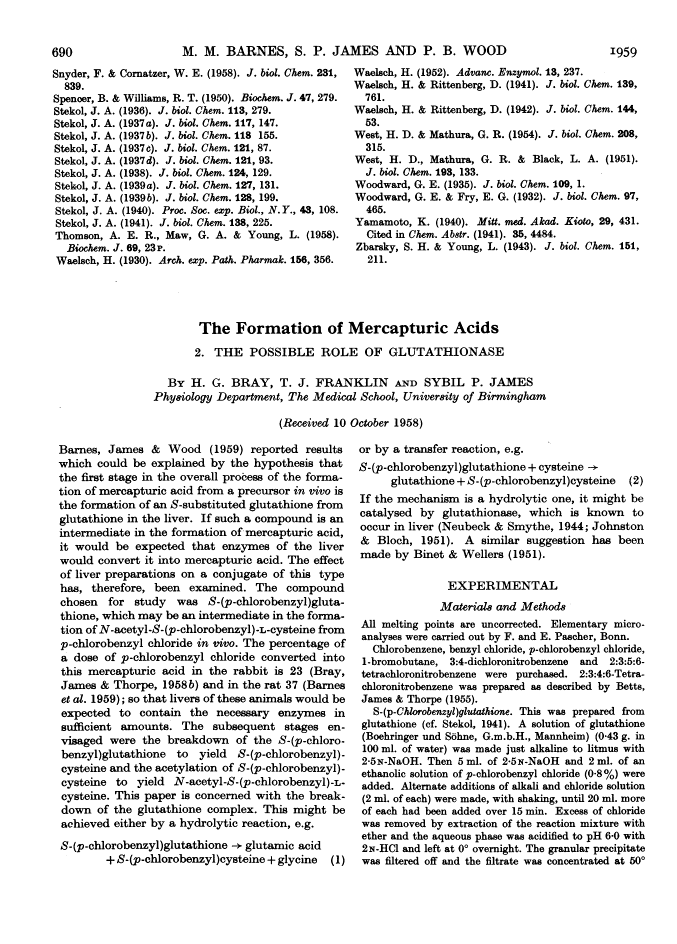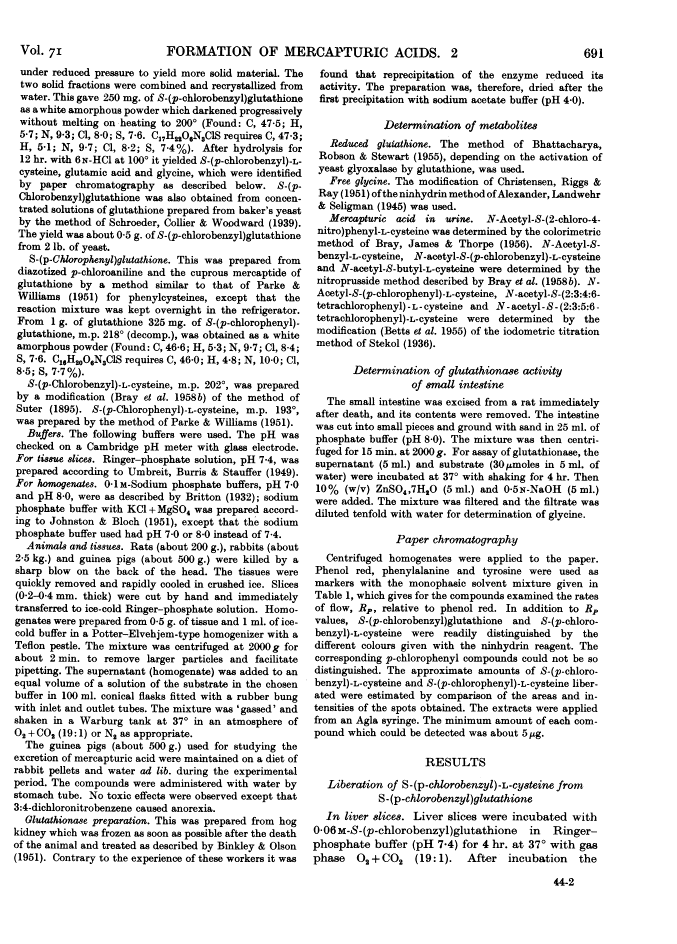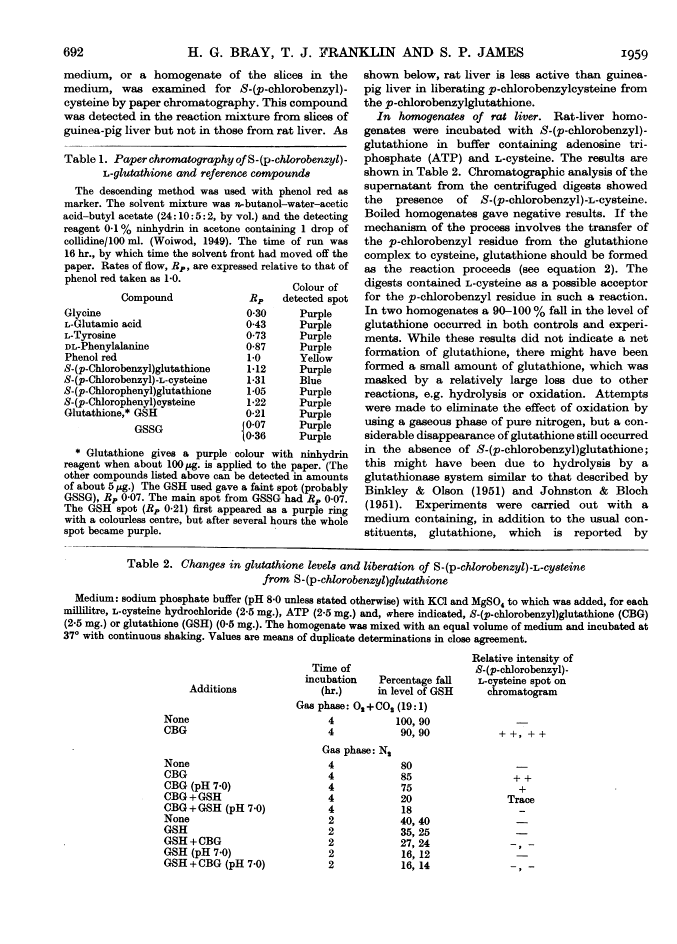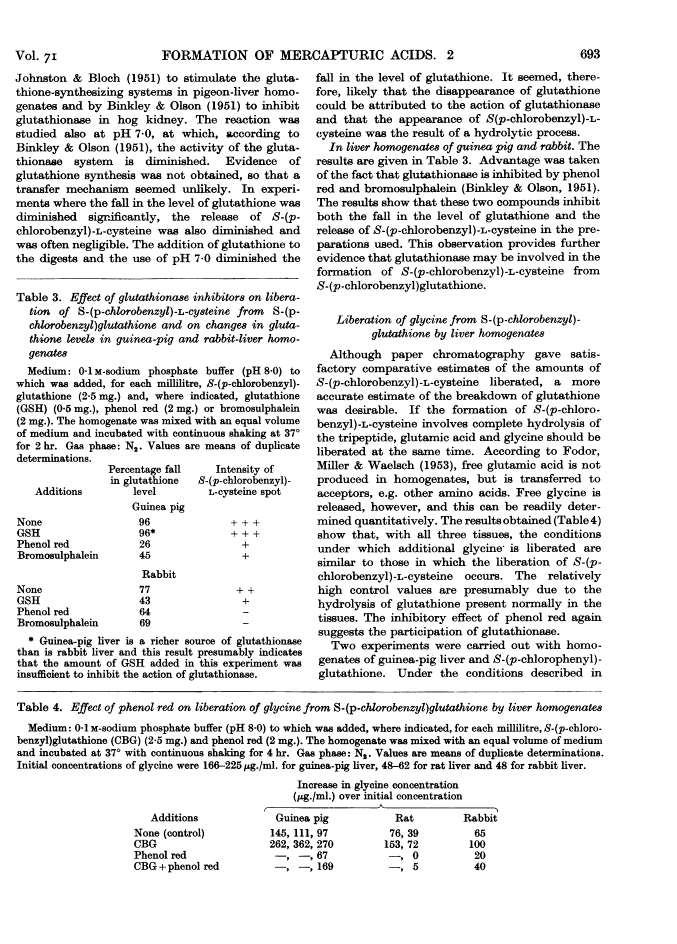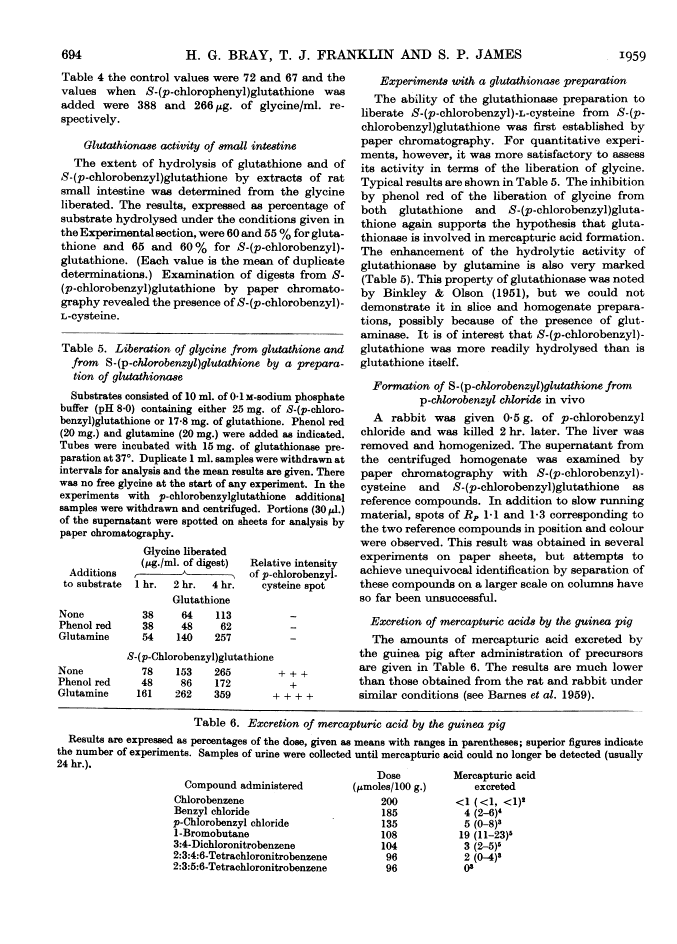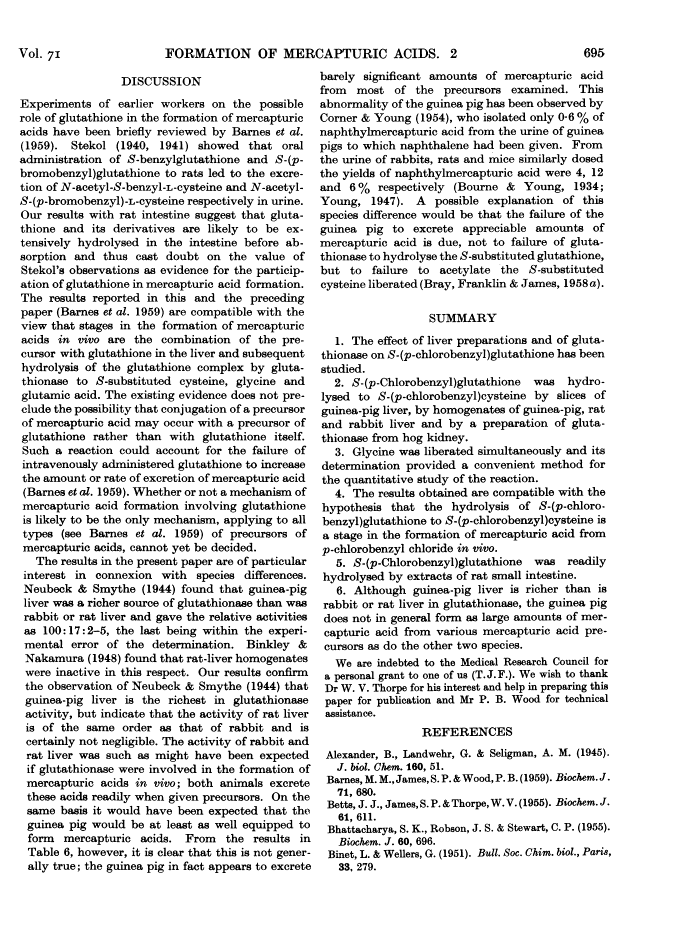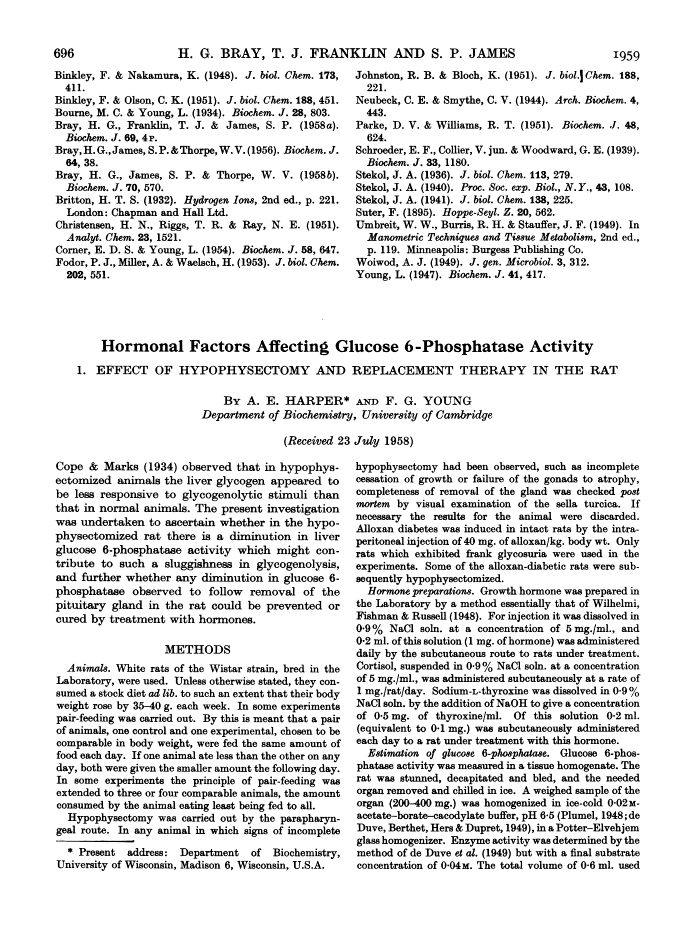Abstract
Free full text

The formation of mercapturic acids. 2. The possible role of glutathionase
Full text
Full text is available as a scanned copy of the original print version. Get a printable copy (PDF file) of the complete article (1.1M), or click on a page image below to browse page by page. Links to PubMed are also available for Selected References.
Selected References
These references are in PubMed. This may not be the complete list of references from this article.
- BARNES MM, JAMES SP, WOOD PB. The formation of mercapturic acids. 1. Formation of mercapturic acid and the levels of glutathione in tissues. Biochem J. 1959 Apr;71(4):680–690. [Europe PMC free article] [Abstract] [Google Scholar]
- BETTS JJ, JAMES SP, THORPE WV. The metabolism of pentachloronitrobenzene and 2:3:4:6-tetrachloronitrobenzene and the formation of mercapturic acids in the rabbit. Biochem J. 1955 Dec;61(4):611–617. [Europe PMC free article] [Abstract] [Google Scholar]
- BHATTACHARYA SK, ROBSON JS, STEWART CP. The determination of glutathione in blood and tissues. Biochem J. 1955 Aug;60(4):696–702. [Europe PMC free article] [Abstract] [Google Scholar]
- BINET L, WELLERS G. Rôle du glutathion lors de l'intoxication du rat par le monobromobenzène. Bull Soc Chim Biol (Paris) 1951;33(3-4):279–285. [Abstract] [Google Scholar]
- BINKLEY F, OLSON CK. Metabolism of glutathione. IV. Activators and inhibitors of the hydrolysis of glutathione. J Biol Chem. 1951 Feb;188(2):451–457. [Abstract] [Google Scholar]
- Bourne MC, Young L. The metabolism of naphthalene in rabbits. Biochem J. 1934;28(3):803–808. [Europe PMC free article] [Abstract] [Google Scholar]
- BRAY HG, JAMES SP, THORPE WV. The metabolism of the monochloronitrobenzenes in the rabbit. Biochem J. 1956 Sep;64(1):38–44. [Europe PMC free article] [Abstract] [Google Scholar]
- BRAY HG, JAMES SP, THORPE WV. Metabolism of some omega-halogenoalkylbenzenes and related alcohols in the rabbit. Biochem J. 1958 Dec;70(4):570–579. [Europe PMC free article] [Abstract] [Google Scholar]
- Eagle E, Britton SW. THE EFFECT OF CORTICO-ADRENAL EXTRACT ON ENERGY OUTPUT. Science. 1932 Feb 19;75(1938):221–222. [Abstract] [Google Scholar]
- CORNER ED, YOUNG L. Biochemical studies of toxic agents. VII. The metabolism of naphthalene in animals of different species. Biochem J. 1954 Dec;58(4):647–655. [Europe PMC free article] [Abstract] [Google Scholar]
- FODOR PJ, MILLER A, WAELSCH H. Quantitative aspects of enzymatic cleavage of glutathione. J Biol Chem. 1953 Jun;202(2):551–565. [Abstract] [Google Scholar]
- PARKE DV, WILLIAMS RT. Studies in detoxication. 37. Metabolism of benzene: examination of the glucuronide fraction of rabbit urine after administration of benzene; isolation of phenylglucuronide. Biochem J. 1951 May;48(5):621–624. [Europe PMC free article] [Abstract] [Google Scholar]
- Schroeder EF, Collier V, Woodward GE. A simplified method for the isolation of glutathione from yeast. Biochem J. 1939 Aug;33(8):1180–1181. [Europe PMC free article] [Abstract] [Google Scholar]
- Young L. The metabolic conversion of naphthalene to 1:2-dihydronaphthalene-1:2-diol. Biochem J. 1947;41(3):417–422. [Europe PMC free article] [Abstract] [Google Scholar]
Associated Data
Articles from Biochemical Journal are provided here courtesy of The Biochemical Society
Full text links
Read article at publisher's site: https://doi.org/10.1042/bj0710690
Read article for free, from open access legal sources, via Unpaywall:
https://europepmc.org/articles/pmc1196859?pdf=render
Citations & impact
Impact metrics
Citations of article over time
Alternative metrics

Discover the attention surrounding your research
https://www.altmetric.com/details/170509205
Article citations
Renal Glutathione: Dual roles as antioxidant protector and bioactivation promoter.
Biochem Pharmacol, 228:116181, 29 Mar 2024
Cited by: 0 articles | PMID: 38556029
Review
Glutathione transferase zeta: discovery, polymorphic variants, catalysis, inactivation, and properties of Gstz1-/- mice.
Drug Metab Rev, 43(2):215-225, 08 Feb 2011
Cited by: 14 articles | PMID: 21303221
Review
The development of drug metabolism research as expressed in the publications of ASPET: Part 2, 1959-1983.
Drug Metab Dispos, 36(6):981-985, 05 Mar 2008
Cited by: 0 articles | PMID: 18322071
Drug metabolism and pharmacogenetics: the British contribution to fields of international significance.
Br J Pharmacol, 147 Suppl 1:S89-99, 01 Jan 2006
Cited by: 8 articles | PMID: 16402125 | PMCID: PMC1760745
Glutathione and its role in cellular functions.
Free Radic Biol Med, 27(9-10):916-921, 01 Nov 1999
Cited by: 735 articles | PMID: 10569624
Review
Go to all (50) article citations
Similar Articles
To arrive at the top five similar articles we use a word-weighted algorithm to compare words from the Title and Abstract of each citation.
[The formation of a reaction product of cysteine and N-(chloroacetyl)-tyrosine and its hydrolysis by proteolytic enzymes].
Bull Soc Chim Biol (Paris), 40(12):1835-1847, 01 Jan 1958
Cited by: 1 article | PMID: 13629224
Pharmacologically-active polypeptide formed from blood globulin by a cysteine-activated protease from Clostridium histolyticum.
Biochim Biophys Acta, 22(1):87-95, 01 Oct 1956
Cited by: 8 articles | PMID: 13373851
The action of carboxypeptidase on different human haemoglobims.
Biochim Biophys Acta, 20(2):400-402, 01 May 1956
Cited by: 8 articles | PMID: 13328871
Effect of age on enzymic release of amino acids from aorta tissue.
J Gerontol, 9(3):251-261, 01 Jul 1954
Cited by: 1 article | PMID: 13184108
